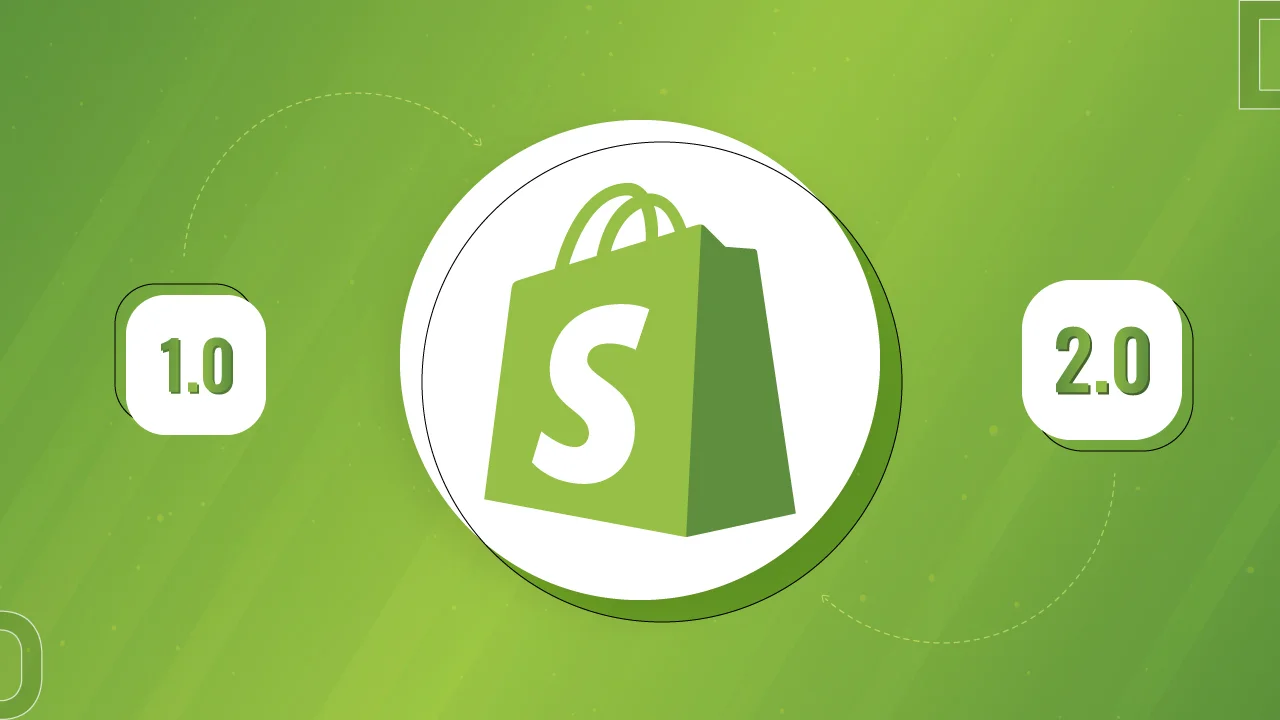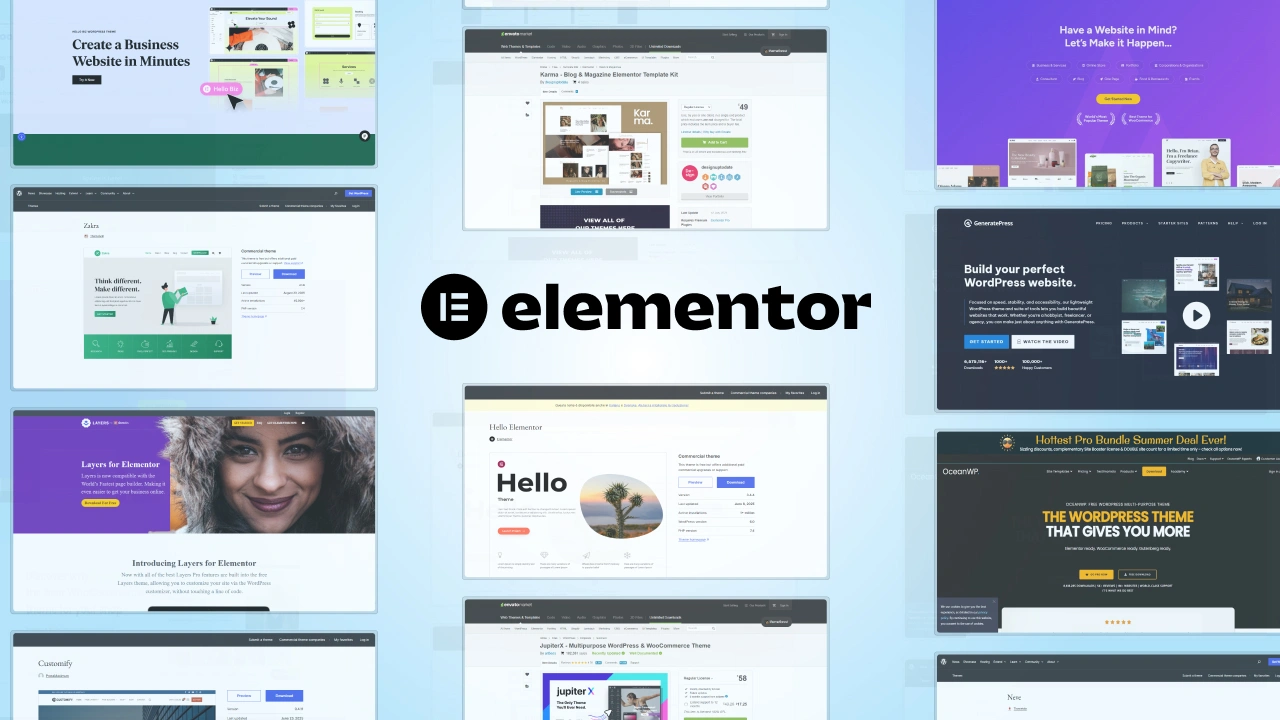Shopify 1.0 and Shopify 2.0: two versions, one name, but worlds apart in functionality. Whether you’re starting fresh or considering an upgrade, understanding these distinctions is important for maximizing your online store’s potential.In this blog post, we will understand the core differences between Shopify 1.0 and its updated successor, Shopify 2.0, highlighting the unique benefits of each. By the end, you’ll have a clear path to choosing the best fit for your e-commerce ambitions.
What is Shopify 1.0?
Shopify 1.0 was the original version of Shopify’s e-commerce platform. It offered basic tools for setting up online stores, managing inventory, and processing payments.It was small businesses’ favorite as it was easy to use and affordable. However, it had some limitations, especially in customization, scalability, and advanced features.
What is in the Shopify 2.0 Release?

Shopify 2.0 introduced several enhancements to address the limitations of Shopify 1.0.Unlike the old version, it offers more advanced customization options, enhanced performance, and better integration with third-party tools. Here are the key improvements you’ll see in Shopify 2.0:
- Enhanced Customization: You can now create custom templates and designs without having to code much. The “Sections Everywhere” feature lets you easily add, remove, and rearrange content across all pages.
- Improved Performance: The platform loads faster and is more responsive, making for a better user experience and boosting your SEO.
- Advanced Marketing Tools: It integrates better with social media, email marketing platforms, and SEO tools, making your marketing efforts more effective.
- Mobile Optimization: Designed with mobile users in mind, ensuring your store looks great and functions well on smartphones and tablets.
Shopify 1.0 vs Shopify 2.0
| Feature | Shopify 1.0 | Shopify 2.0 |
|---|---|---|
| Customization | Limited to some basic theme settings and homepage sections. | Much deeper level of customization on every page with ‘Sections Everywhere’. |
| User Interface | It is indeed simple with zero hassle, but as to deep-level customization, it lacks it. | Improved UI and much more intuitive. Plus, design is much more flexible. |
| Performance | Standard, hence perfect for small retailers, but not too high. | Performance improvements and store loading time on the front end for all store sizes. |
| App Integration | Mostly manual integration for a developer to do. | New advanced theme app extensions; hence it’s easy and seamless to add the add. |
| Developer Tools | Very few developer tools. | Comes with more developer tools, newer APIs, and newer capabilities to develop a theme. |
| Scalability | Ideal for scale online stores of smaller sizes. | Best suited for more mature businesses or large-scale operations because of its scalable features. |
| E-commerce features | Basic e-commerce features, more for simple usage. | An advanced set of features that make the purchase path more pleasant for the customer and the power of analysis even better. |
Key Differences Between Shopify 1.0 and Shopify 2.0
- Theme Architecture: Shopify 1.0 limited customization primarily to the homepage. In contrast, Shopify 2.0 introduces “Sections Everywhere,” allowing drag-and-drop control feature over the layout of all your store’s pages.
- Content Management: Adding custom content in 1.0 often required coding. Shopify 2.0 empowers you to create custom meta fields for product and collection pages without needing to code.
- Theme Editor: Shopify 1.0’s theme editor offered basic functionality. With 2.0, the editor gains new features like section editing and a visual interface for better control over your store’s look and feel.
- Developer Tools: Shopify 2.0 boasts a wider range of developer tools, including the Shopify CLI. This command-line interface streamlines theme development and allows for faster testing and deployment.
- Theme Reference: Shopify 2.0 introduces the “Dawn” theme as a new standard for theme development. This theme is faster and more mobile-friendly than the previous default theme in 1.0.
- App Integration: Shopify 2.0 improves app integration by streamlining how apps interact with your store’s theme. This reduces potential conflicts and makes it easier to manage your app ecosystem.
- Marketing Tools: While both versions offer marketing tools, Shopify 2.0 might have an edge with its focus on SEO optimization and potentially more advanced features as the platform evolves.
Benefits of Upgrading to Shopify 2.0

Upgrading to Shopify 2.0 brings several tangible benefits that can significantly enhance your e-commerce operations:
- Improved User Experience for Customers and Merchants
Shopify 2.0 introduces a sleeker and more intuitive user interface, making it easier for customers to navigate your online store and find the products they’re looking for. The updated design also enhances the backend experience for merchants, simplifying store management tasks and improving overall efficiency.
- Enhanced Security Features
Security is a top priority for any online business. Shopify 2.0 incorporates advanced security features to protect your store and customer data from potential threats. This includes robust encryption standards, secure payment gateways, and regular security updates to mitigate vulnerabilities.
- Better Support for Mobile Commerce
With the growing trend of mobile shopping, Shopify 2.0 ensures your store is fully optimized for mobile devices. Responsive design elements and mobile-friendly features enhance the browsing and purchasing experience for customers accessing your site from smartphones or tablets. This not only improves user engagement but also boosts conversion rates.
Migration Process and Considerations
Migrating from Shopify 1.0 to 2.0 involves several steps and considerations to ensure a smooth transition for your online store:
- Evaluate Compatibility: Check if your current Shopify theme and apps are compatible with Shopify 2.0. Some themes and apps may need updates or replacements.
- Backup Data: Before starting the migration process, ensure you have a complete backup of your Shopify 1.0 store data, including products, orders, customer information, and settings.
- Review Customizations: Note any custom code or modifications made to your Shopify 1.0 store. These may need adjustments to work seamlessly with Shopify 2.0.
- Upgrade Process: Shopify provides tools and documentation to assist with the upgrade process. Follow their guidelines to initiate the upgrade from your Shopify admin dashboard.
- Test Thoroughly: After migrating, thoroughly test your Shopify 2.0 store to ensure all functionalities, including checkout processes, payment gateways, and third-party integrations, are working correctly.
Potential Challenges and How to Overcome Them
- Theme Compatibility Issues: If your current theme isn’t compatible with Shopify 2.0, consider switching to a Shopify 2.0-ready theme or hire a expert Shopify developer to update your existing theme.
- App Compatibility: Some apps you’re using in Shopify 1.0 may not be available or fully functional in Shopify 2.0. Research alternatives or contact app developers for compatibility updates.
- Custom Code Adjustments: Customizations made to your Shopify 1.0 store may require adjustments to align with Shopify 2.0’s updated framework. Work closely with a developer if needed.
- Data Migration Errors: Ensure data migration is done accurately to avoid issues such as missing products or incomplete customer records. Double-check migrated data against your backup.
Best Practices for a Smooth Transition
- Plan Ahead: Schedule the migration during off-peak hours to minimize disruption to your business operations.
- Communicate with Customers: Notify customers about any scheduled downtime or changes during the migration process to manage expectations.
- Train Staff: If your team manages the Shopify backend, provide training on new features and changes introduced in Shopify 2.0.
- Monitor Performance: Keep an eye on your Shopify 2.0 store post-migration to promptly address any issues that may arise and ensure optimal performance.
📖 Also Read: How to Start a Headless Shopify Store?
Which Version is Right for You?
Choosing between Shopify 1.0 and 2.0 depends on several key factors that align with your business needs and goals. Here are some considerations to help you make an informed decision:
Factors to Consider
- Business Size: Larger businesses with higher traffic volumes and more complex needs will benefit more from Shopify 2.0. The enhanced performance, scalability, and customization options cater to bigger operations. Smaller businesses might find Shopify 1.0 sufficient, but the additional features of 2.0 can still offer significant advantages.
- Goals: If your goal is to expand your online presence, enhance user experience, and leverage advanced features, Shopify 2.0 is the way to go. For businesses content with maintaining current operations without major changes, Shopify 1.0 might be adequate.
- Budget: Upgrading to Shopify 2.0 might involve additional costs, including potential theme or app purchases and possible developer fees for customizations. Evaluate your budget to see if the investment aligns with your anticipated returns.
Recommendations Based on Specific Needs
- Startups: For new businesses, starting with Shopify 2.0 is recommended. You’ll have access to the latest features, ensuring your store is future-proof and competitive from the get-go. The improved tools and customization options can help establish a strong online presence.
- Established Businesses: If you already have a Shopify 1.0 store, consider your current performance and growth trajectory. If you’re facing limitations with your current setup, especially in terms of scalability and user experience, upgrading to Shopify 2.0 can provide the necessary enhancements. Businesses aiming for significant growth should definitely consider the upgrade.
- Budget-Conscious Businesses: If your budget is tight, evaluate the immediate benefits of Shopify 2.0 against the costs. While there might be an initial outlay, the long-term benefits of better performance, security, and mobile optimization can lead to higher sales and customer satisfaction, offsetting the upfront expenses.
Future of Shopify
Shopify has come a long way from its early days, continually evolving to meet the needs of online businesses. Shopify 2.0 represents a significant leap forward, offering enhanced features, better performance, and more flexibility for merchants. This evolution shows Shopify’s commitment to staying at the forefront of e-commerce technology, helping businesses thrive in an ever-changing market.
Having said that, the future of Shopify looks promising, with ongoing updates and improvements that will likely introduce even more powerful tools and integrations. As e-commerce trends continue to evolve, Shopify is well-positioned to adapt and provide solutions that help businesses of all sizes succeed.
If you’re considering upgrading to Shopify 2.0, now is a great time to explore the benefits and make the switch. Upgrading can bring improved user experiences, enhanced security, and better support for mobile commerce, which are essential for staying competitive.
📖 Also Read: Shopify Store Design 2026
Consult our Shopify experts who can guide you through the migration process and ensure a smooth transition.





